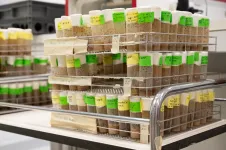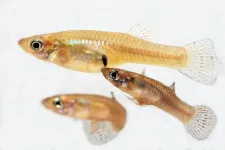A universal approach to tailoring soft robots
An integrated design optimisation and fabrication workflow opens new opportunities for tailoring the mechanical properties of soft machines.
2021-07-07
(Press-News.org) By combining two distinct approaches into an integrated workflow, Singapore University of Technology and Design (SUTD) researchers have developed a novel automated process for designing and fabricating customised soft robots. Their method, published in Advanced Materials Technologies, can be applied to other kinds of soft robots--allowing their mechanical properties to be tailored in an accessible manner.
Though robots are often depicted as stiff, metallic structures, an emerging class of pliable machines known as soft robots is rapidly gaining traction. Inspired by the flexible forms of living organisms, soft robots have wide applications in sensing, movement, object grasping and manipulation, among others. Yet, such robots are still mostly fabricated through manual casting techniques--limiting the complexity and geometries that can be achieved.
"Most fabrication approaches are predominantly manual due to a lack of standard tools," said SUTD Assistant Professor Pablo Valdivia y Alvarado, who led the study. "But 3D printing or additive manufacturing is slowly coming into play as it facilitates repeatability and allows more complex designs--improving quality and performance."
According to Dr Valdivia y Alvarado, embedded 3D printing--wherein various material inks are extruded in a supportive matrix--is especially suited for fabricating soft robots made of multiple materials or composites. However, to ensure that these robots are optimally designed, the team turned to topology optimisation (TO), where mathematical models are employed to design bespoke structures within a set of constraints.
By automating these two key steps in a single framework, the authors hoped to develop an integrated workflow for creating customised soft robots and minimise potential errors along the way. For the study, the group used a swimming autonomous robot inspired by batoids. The workflow starts by defining the robot's fin geometry, after which TO is used to generate the desired structure with desired properties within prescribed material and motion constraints. The optimised design is then transformed into a code that is read by the team's custom-built 3D printers, which in turn fabricate the robot.
The batoid-inspired soft robots were designed to survive the marine environment's harsh conditions and the approach focused on tailoring their fin composition and assessing how these changes could impact the fabricated robot's swimming performance.
Specifically, three types of fins were created--with two fins respectively made of soft and stiff materials as well as a third fin designed through TO combining the two materials. Unlike the first two fins, which were fabricated using traditional methods, the third composite fin was made following the integrated workflow.
Incredibly, the soft robot with the optimised composite fins was 50 per cent faster than its counterpart with the traditionally casted soft fin, with a speed slightly higher than the robot with the hard fin. The same prototype with the composite fin also turned roughly 30 per cent faster compared to the soft fin and had the smallest turning radius among the three robots--making it better at maneuvering through water.
Having successfully demonstrated the effectiveness of their approach, Dr Valdivia y Alvarado noted that their workflow for fabricating optimised, multi-material soft robots can be universally applied to design other soft robots.
"For example, if we're building a sensor, our objective in TO could be to tailor the electrical conductivity of certain portions of the structure," said Dr Valdivia y Alvarado. "Customising optical, thermal, electrical, as well as other physico-chemical properties would also be interesting for other applications."
INFORMATION:
ELSE PRESS RELEASES FROM THIS DATE:
2021-07-07
Despite having been formalized as a species in 1936, Wolbachia pipientis remains an elusive microbe. The reason why relates to the relationship it establishes with its hosts. Wolbachia lives inside the cells of 40% of the arthropods, in their majority insects, intertwined in a symbiosis so complex that it can no longer survive on its own. "Guessing what it takes to grow and manipulate it outside the host might not be possible", says Luís Teixeira, IGC principal investigator. And, so far, despite countless attempts, no one has succeeded in culturing this bacterium or modifying its genetic sequence.
Before joining the team led by Luís Teixeira, Elves Duarte was interested in studying the symbiosis between ...
2021-07-07
East Hanover, NJ. July 7, 2021. A team of researchers identified nine meaningful reasons that prevent people with disabilities from seeking employment. Their findings provide a much-needed understanding of this population's motives for remaining unemployed, which can inform programs and policies that promote labor force participation of people with disabilities. The article, "Understanding Persons with Disabilities' Reasons for Not Seeking Employment" (doi: 10.1177/00343552211006773) was published in Rehabilitation Counseling Bulletin on April 15, 2021.
The authors are Denise C. Fyffe, PhD, Anthony H. Lequerica, PhD, and John O'Neill, PhD, of Kessler Foundation; Courtney Ward-Sutton, PhD, and Natalie F. Williams, PhD, of Langston University; and Vidya Sundar, OT, PhD, ...
2021-07-07
Palo Alto, CA--Dehydrated plant seeds can lay dormant for long periods--over 1,000 years in some species--before the availability of water can trigger germination. This protects the embryonic plant inside from a variety of environmental stresses until conditions are favorable for growth and survival. However, the mechanism by which the baby plant senses water and reactivates cellular activity has remained a mystery until now.
New work jointly led by Carnegie's Yanniv Dorone and Sue Rhee and Stanford University's Steven Boeynaems and Aaron Gitler discovered a protein that plays a critical "go, or no-go" role in this process--halting germination if the soil's hydrological conditions are ...
2021-07-07
The principle that form follows function does not only apply to design and architecture. It also applies to biology. Every organism is a universe that lives thanks to the activities of tens of thousands of nanomachines, whose functions depend on their forms. Biologists say macromolecular complexes instead of nanomachines and structure instead of form, but the idea is the same: know the form and you will understand the function. Now, a group at the Spanish National Cancer Research Centre (CNIO) has helped determine the structure of a nanomachine essential for the functioning of another, mTOR, which plays fundamental roles in ...
2021-07-07
A team led by researchers from Queen Mary University of London has developed a new artificial intelligence (AI) tool that is able to automatically measure the amount of fat around the heart from MRI scan images.
Using the new tool, the team was able to show that a larger amount of fat around the heart is associated with significantly greater odds of diabetes, independent of a person's age, sex, and body mass index.
The research is published in the journal Frontiers in Cardiovascular Medicine and is the result of funding from the CAP-AI programme, which is led by Barts Life Sciences, a research and innovation partnership between Queen Mary University of London and Barts Health NHS Trust.
The distribution of fat in the body can influence a person's ...
2021-07-07
Many people instinctively associate mucus with something disgusting, but in fact, it has incredibly many valuable functions for our health. It keeps track of our important intestinal flora and feeds the bacteria. It covers all internal surfaces of our body, and, as a barrier to the outside world, it helps us protect ourselves from infectious diseases.
This is because mucus acts as a filter that keeps the bacteria in or out, and the bacteria feed on the sugars in the mucus between meals. So, if we can produce the mucus that is already present in the body with the right sugars, it might be used in brand new medical treatments.
Now, researchers from the DNRF Centre ...
2021-07-07
Physicists of Ruhr-Universität Bochum (RUB) have taken spectacular pictures that allow the ignition process of plasma under water to be viewed and tracked in real time. Dr. Katharina Grosse has provided the first data sets with ultra-high temporal resolution, supporting a new hypothesis on the ignition of these plasmas: In the nanosecond range, there is not enough time to form a gas environment. Electrons generated by field effects lead to the propagation of the plasma. The nanosecond plasma ignites directly in the liquid, regardless of the polarity of the voltage. The report from the Collaborative Research Centre 1316 "Transient Atmospheric Pressure Plasmas: from Plasma to Liquids to Solids" has been published in the Journal of Applied Physics and Rubin, the ...
2021-07-07
COLUMBUS, Ohio - Female vampire bats establish an egalitarian community within a roost rather than a society based on a clear hierarchy of dominance that is often seen in animal groups, a new study suggests.
Researchers observed more than 1,000 competitions for food among a colony of 33 adult female bats and juveniles living in captivity, assigning a rank to each bat based on a calculation of wins and losses in those contests.
The team found that, unlike in many mammal societies, the higher-ranking animal didn't necessarily win every bout over food, and there was a randomness to the ranking order - no specific quality they measured gave a bat a better chance at dominance, so any adult female had an equal opportunity to rank very high or very low on a scale of ...
2021-07-07
Environmental education provision needs greater investment and innovation if future generations are to be able to respond fully to the climate emergency, experts have said.
The deepening environmental crisis will continue to worsen if there is not significant support and investment in environmental and science education, researchers have warned. Reforms would help young people to address the complex, interlinked and dynamic issues of our contemporary situation.
The experts argue Governments and other organisations must direct more funding to education innovation in response to consistent warnings from scientists about trends in the deteriorating state of ecosystems, biodiversity and climate, amongst other environmental issues.
Writing in Environmental Education ...
2021-07-07
In mosquitofish, of the genus Gambusia, male fish are smaller than females - sometimes only half the size. Biologists had previously assumed that smaller male mosquitofish had at least some reproductive advantages. Researchers from the transregional collaborative research centre NC³ at Bielefeld University have shown in a systematic review and meta-analysis that larger mosquitofish are actually more successful at reproduction: they can, for instance, better challenge their rivals; they produce more sperm; and they are preferred by female fish. The re-searchers are presenting their findings today (07.07.2021) in the Journal of Animal Ecology.
Mosquitofish are small fish with nondescript coloring of the genus Gambusia, which contains some 45 species. ...
LAST 30 PRESS RELEASES:
[Press-News.org] A universal approach to tailoring soft robots
An integrated design optimisation and fabrication workflow opens new opportunities for tailoring the mechanical properties of soft machines.



